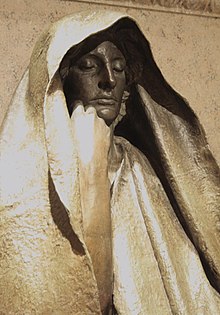Adams Memorial (Saint-Gaudens)
Adams Memorial | |
 The Adams Memorial by Augustus Saint-Gaudens and Stanford White (2007) | |
| Location | Rock Creek Cemetery Webster St. and Rock Creek Church Rd., NW. Washington, D.C. |
|---|---|
| Coordinates | 38°56′50.5″N 77°0′37″W / 38.947361°N 77.01028°W |
| Built | 1891 |
| Architect | Augustus Saint-Gaudens Stanford White |
| NRHP reference No. | 72001420 |
| Significant dates | |
| Added to NRHP | March 16, 1972 |
| Designated DCIHS | November 8, 1964 |
The Adams Memorial is a
History
Erected in 1891, the monument was commissioned by author/historian

Henry Adams, who traveled to Japan with
Saint-Gaudens's name for the bronze figure is The Mystery of the Hereafter and The Peace of God that Passeth Understanding, but the public commonly called it Grief – an appellation that Henry Adams apparently disliked. In a letter addressed to Homer Saint-Gaudens, on January 24, 1908, Adams instructed him:
"Do not allow the world to tag my figure with a name! Every magazine writer wants to label it as some American patent medicine for popular consumption – Grief, Despair, Pear's Soap, or Macy's Men's Suits Made to Measure. Your father meant it to ask a question, not to give an answer; and the man who answers will be damned to eternity like the men who answered the Sphinx."
In his The Education ... Henry Adams reflects on the statue and its interpreters: "His first step, on returning to Washington, took him out to the cemetery known as Rock Creek, to see the bronze figure which St. Gaudens had made for him in his absence. ... in all that it had to say, he never once thought of questioning what it meant. He supposed its meaning to be the one commonplace about it – the oldest idea known to human thought. ... As Adams sat there, numbers of people came, for the figure seemed to have become a tourist fashion, and all wanted to know its meaning. ... Like all great artists, St. Gaudens held up the mirror and no more."[6]
At the time of Saint-Gaudens's death, the statue was well known as an important work of American sculpture. Its popularity inspired at least one prominent copy, the Black Aggie, which was sold to General Felix Agnus for his gravesite.[7][8]
On March 16, 1972, the Adams Memorial was listed on the National Register of Historic Places.
References
- ^ OCLC 70046094.
- The Greater Journey: Americans in Paris.[full citation needed]
- ^ "The Third Mind". Augustus Saint-Gaudens. Solomon R. Guggenheim Museum. Retrieved 21 February 2009.
- ISBN 0-375-50327-7.for ruining 'nice blocks of white marble with his classic Sybils'
[Clover Adams chastised] sculptor William Wetmore Story
- ^ Field, Cynthia R. (1995). "The Adams Memorial" (PDF). Office of Architectural History and Historic Preservation. Smithsonian Preservation Quarterly. The Smithsonian Institution. Archived from the original (PDF) on 6 February 2009. Retrieved 31 January 2009.
Adams, who said his own name for it was "The Peace of God", stated that "The whole meaning and feeling of the figure is in its universality and anonymity."
- ^ Adams, Henry (1918). "Chapter XXI". The Education of Henry Adams. Massachusetts Historical Society.
- S2CID 192155944.
- ^ Friedrich, Otto. Clover: The tragic love story of Clover and Henry Adams and their brilliant life in America's gilded age. – An informative and engaging study of the memorial and the relationship between Clover and Henry Adams.[full citation needed] See also, Clover Adams: A Gilded and Heartbreaking Life by Natalie Dykstra, New York:Houghton Mifflin Harcourt, 2013.
External links
- Adams Memorial photos[permanent dead link] at Historic American Buildings Survey
- Cultural Tourism D.C. - The Adams Memorial
- Save Outdoor Sculpture Survey
- Smithsonian American Art Museum and the Renwick Gallery - Copy of the Adams Memorial
- Augustus Saint-Gaudens, Master Sculptor, exhibition catalog fully online as PDF from The Metropolitan Museum of Art, which contains material on the Adams Memorial

